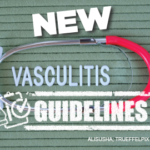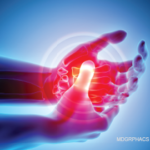 In 2021, the ACR—in concert with the Vasculitis Foundation (VF)—released four new vasculitis guidelines, one each on: 1) anti-neutrophil cytoplasmic antibody (ANCA) associated vasculitis, 2) giant cell arteritis (GCA) and Takayasu arteritis, 3) polyarteritis nodosa and 4) Kawasaki disease.1-3,5 The guideline development process is complex. For the vasculitis guidelines, this process kicked off in June 2017, when the core leadership team formed by the ACR first met in person. The ACR also convened expert and voting panels. Together, the core team and the two panels determined the project’s scope. Members of the literature review team assembled evidence using the most recent nomenclature system for vasculitis, the 2012 Chapel Hill Consensus Conference nomenclature.4 A panel of patients contributed as well. In this series, we discuss the updated recommendations with authors who contributed to each guideline. Read other installments in this series.
In 2021, the ACR—in concert with the Vasculitis Foundation (VF)—released four new vasculitis guidelines, one each on: 1) anti-neutrophil cytoplasmic antibody (ANCA) associated vasculitis, 2) giant cell arteritis (GCA) and Takayasu arteritis, 3) polyarteritis nodosa and 4) Kawasaki disease.1-3,5 The guideline development process is complex. For the vasculitis guidelines, this process kicked off in June 2017, when the core leadership team formed by the ACR first met in person. The ACR also convened expert and voting panels. Together, the core team and the two panels determined the project’s scope. Members of the literature review team assembled evidence using the most recent nomenclature system for vasculitis, the 2012 Chapel Hill Consensus Conference nomenclature.4 A panel of patients contributed as well. In this series, we discuss the updated recommendations with authors who contributed to each guideline. Read other installments in this series.
First up in this series, we talk with Sharon A. Chung, MD, MAS, about the overall vasculitis guideline effort. Dr. Chung is director of the vasculitis clinic at the University of California, San Francisco, and served as the principal investigator of the overall vasculitis guideline effort.
Q: Guidelines can be helpful in a lot of ways, and I think different people use them in different ways, depending on who they are, how they practice and how comfortable they are with diseases. How do you see these particular guidelines impacting clinical practice?
Dr. Chung: The vasculitides aren’t the most common rheumatic diseases, and many practitioners may not have much experience caring for patients with vasculitis. Therefore, the first goal is to have these guidelines serve as a resource for clinicians—in essence, a road map to guide practitioners on how to treat patients with specific types of vasculitis.
The second goal is to help clinicians think about factors that should influence the types of therapies to choose. In these guidelines, we provide alternatives to the recommended treatments and factors to consider when thinking about these alternatives.
The third purpose is to point out where we have gaps in knowledge, and to light a fire under someone to say, ‘Wow, that’ a really important question, and we really should look into it!’ That way, we have more information to make better treatment recommendations the next time.
Q: I’m curious about the process itself: How are people selected, and how did you get to recommendations? What did this look like behind the scenes?




